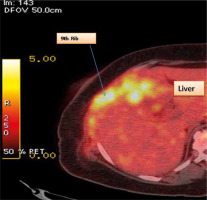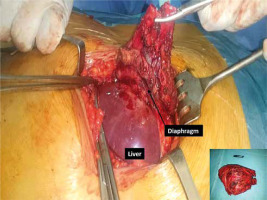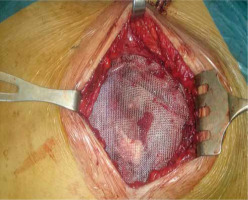Carcinoma of the cervix is the most frequent malignant gynaecological tumour in developing countries. The most frequently reported sites of metastases are lung, bone, and liver [1].
More rarely, it can metastasize to the skin and skeletal muscles [1, 2], but localization to the chest wall is extremely rare. Currently, only 2 cases of chest wall metastases have been reported in the literature, one of which was associated with invasion of the sternal manubrium with invasion of the anterior segment of the culmen. According to our knowledge, no case of metastasis of neoplasia from the cervix involving not only the ribs but also the right diaphragm has been reported. We report a case of a right chest wall and diaphragmatic metachronous metastasis from an endocervix adenocarcinoma.
A 52-year-old patient was treated for epidermoid carcinoma of the cervix in 2013 by radio-chemotherapy, with a good evolution marked by a total remission. The patient was admitted to our department in August 2015 for treatment of a painful right basithoracic mass evolving for 6 months.
Chest computed tomography (CT) and positron emission tomography (PET) scan revealed an infiltrating mass with costal lysis of the 8th, 9th, and 10th ribs and a safety border separating the opposite liver (Figure 1). Complete evaluation of bone and chest revealed no other associated lesion. Preoperative percutaneous biopsy specimen showed an epidermoid carcinoma metastasis.
Intraoperative exploration found a solid mass invading the ribs, adhering to the serratus muscle without invasion, invading the diaphragm (Figure 2). The intervention consisted of a complete removal of the mass with rib resection in free margins and partial resection of the diaphragm with chest wall and diaphragm reconstruction by prosthesis (mesh) (Figure 3).
Pathological analysis of the surgical specimen confirmed the diagnosis. Adjuvant chemotherapy was indicated. The follow-up was uneventful 2 years later. A recurrent disease with pelvic lymph nodes and liver metastasis was subsequently described, and the patient died after chemotherapy complications (sepsis).
In Morocco, cervical cancer is the second most common cancer and the third leading cause of death [3]. This cancer leads to pelvic and extra-pelvic metastases. Extra-pelvic metastases are frequently observed in the lungs, liver, and bones with the lumbar spine and pelvis being the most common sites [1, 4].
More rarely, and even at advanced stages of the disease, cervical cancer can metastasize to the skin with an incidence of between 0.1% and 2%, but also to the skeletal muscles [2, 5]. However, chest wall metastasis is extremely rare, and costal and diaphragmatic locations seem to be exceptional in the literature [6, 7].
Similarly, examination of the patient revealed a right basithoracic mass, which was painful, and chest CT showed an infiltrating mass with costal lysis. The most common differential diagnoses include primary chest wall tumours (benign or malignant), parietal tuberculosis, and metastases to the chest wall from cancers of the breast, pleura, lung, mediastinum, and cavum [8–10].
Moreover, this lesion appeared 2 years after radio-chemotherapy of the primary lesion, the evolution of which resulted in total remission. The time to onset of right parieto-diaphragmatic metachronous metastasis of cancer of the cervix in our case was much shorter than the cases reported by Gabriella et al. (5 years and 4 months) and by Chen et al. (19 years) [6, 7]. We believe that this long delay in the appearance of isolated metastases from the chest wall of cervical cancer is linked to a long period of dormancy of the tumour cells. Hence the interest, after a total remission of the primary lesion, in following our patients over the long term as one would follow a case of chronic disease, with a view to diagnosing a metastasis earlier.
Finally, after surgical treatment, adjuvant radiotherapy was the only indication after the multidisciplinary consultation meeting.
The evolution was still marked by total remission of the right parieto-diaphragmatic metastasis after 6 months of radiotherapy.
In conclusion, isolated chest wall metastasis from cervical cancer is extremely rare, and rib localization with diaphragmatic invasion is exceptional. However, it is important to systematically search for any suspicion of neoplastic lesion to the chest wall for cancer of the cervix, and the evolution may be favourable after surgery associated with adjuvant treatment based on radiotherapy or chemotherapy.








